Images: Peering Back to the Big Bang & Early Universe
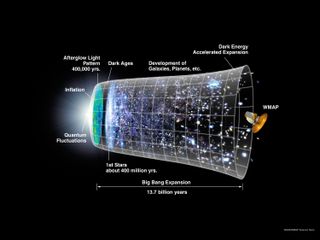
Big Bang Diagram
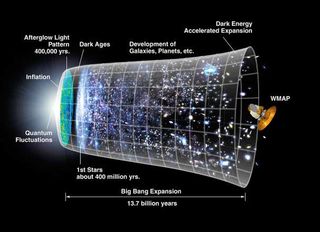
The Big Bang theory proposes that the universe began as an extremely hot and dense dot only a few millimeters wide. It since grew over 13.7 billion years into the vast and cooler expanding cosmos that presently exists. An extension of the Big Bang model, inflation, poses that the universe initially expanded far faster than the speed of light and grew from a subatomic size to a golf-ball size almost instantaneously, shown in this diagram.
It took quite a bit more than seven days to create the universe as we know it today. SPACE.com looks at the mysteries of the heavens in our series: The History & Future of the Cosmos. This is Part 2 in that series.
Astronomers Detect First Split-Second of the Universe
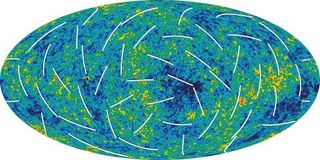
The Wilkinson Microwave Anisotropy Probe (WMAP) has produced a new, more detailed picture of the infant universe. Colors indicate "warmer" (red) and "cooler" (blue) spots. The white bars show the "polarization" direction of the oldest light. This new information helps to pinpoint when the first stars formed and provides new clues about events that transpired in the first trillionth of a second of the universe.
After Big Bang Came Moment of Pure Chaos, Study Finds
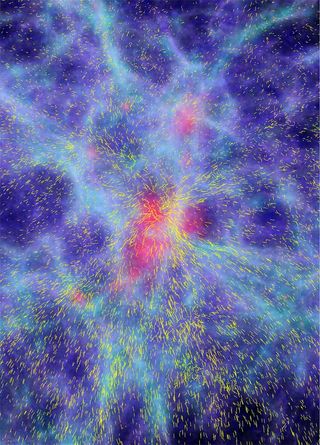
Snapshot from a computer simulation of the formation of large-scale structures in the universe, showing a patch of 100 million light-years and the resulting coherent motions of galaxies flowing toward the highest mass concentration in the center.
Star Observations Could Solve Cosmic Riddle
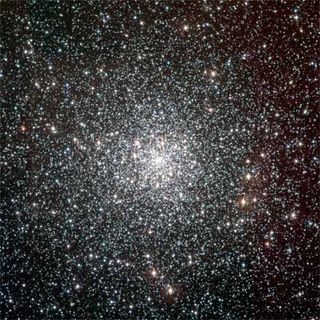
The globular cluster NGC 6397 contains around 400,000 stars and is located about 7,200 light years away in the southern constellation Ara. With an estimated age of 13.5 billion years, it is likely among the first objects of the galaxy to form after the Big Bang.
New Model of the Early Universe
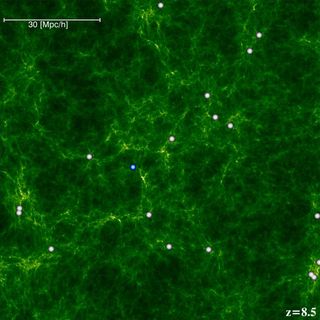
The universe, 590 million years after the Big Bang, may have looked like this, according to computer simulations, with some stretches of dark matter (green) and galaxies with varying luminosity of star formation (yellow is brightest).
Hubble Lifts Fog on Early Universe

This image shows primordial dwarf galaxy candidates circled in green. Three enlargements at right show several dwarf objects that are at the limits of Hubble's present instrument capabilities in September 2004. The Hubble UDF is a small region of sky in the direction of the southern constellation Fornax. The faintest objects are less than one four-billionth the brightness of stars that can be seen with the naked eye.
Explanation of Dark Matter Might Lie in Origin of Stars

One scenario envisioning the creation of the earliest stars suggests that dark matter particles are very light and can zip through space more quickly. These warm dark matter models predict that dark matter formed long filamentary structures along which stars appeared like pearls on a string. In this simulation, a gas filament condenses and then fragments to form the first stars. The blue shading in this image reflects changes in the gas's density.
Get the Space.com Newsletter
Breaking space news, the latest updates on rocket launches, skywatching events and more!
Some of the Universe's First Galaxies Discovered
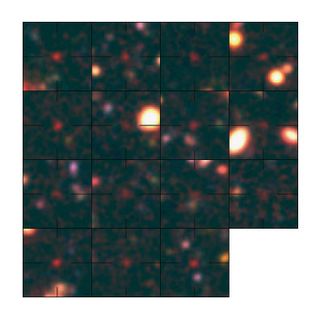
This is a composite of false color images of the galaxies found at the early epoch around 800 million years after the Big Bang. The upper left panel presents the galaxy confirmed in the 787 million year old universe. These galaxies are in the Subaru Deep Field.
Farthest Galaxy Found, Perhaps
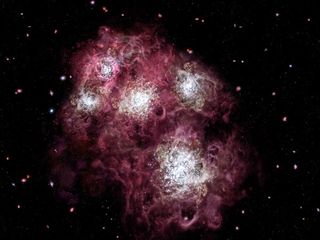
An artist's impression of an embryonic galaxy brimming with star birth in the early universe, less than a billion years after the Big Bang. This image was prompted by the discovery in 2008 of a young galaxy, called A1689-zD1, that was born about 700 million years after the Big Bang.
Violent Explosion Is Most Distant Object Ever Seen
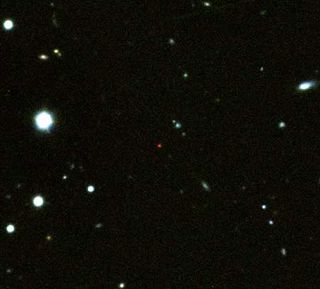
Gamma-ray burst GRB 090423 is the small, very red source in the center of this image. The red color is indicative of its great distance — about 13.1 billion light years — since all the optical light has been absorbed by intergalactic hydrogen gas, leaving only infrared light. All the other galaxies and stars in the image are much closer to us and just happen lie in the same part of the sky. GRB 090423 was the most distant object observed at the time of its discovery in 2009, and astronomers hope that distant gamma-ray bursts such as GRB 090423 will give them information about the early universe following the Big Bang.
Black Holes Gave Our Baby Universe a Fever
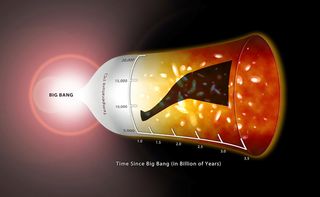
A graph showing the temperature of the intergalactic medium when the universe was between one and three billion years old, overlaid on an artist's impression of the emergence of galaxies over the same period. The shaded region shows the range of possible temperatures measured from the team's data. The warming occurred at a time when the growth of galaxies was in full swing.
Join our Space Forums to keep talking space on the latest missions, night sky and more! And if you have a news tip, correction or comment, let us know at: community@space.com.

Space.com is the premier source of space exploration, innovation and astronomy news, chronicling (and celebrating) humanity's ongoing expansion across the final frontier. Originally founded in 1999, Space.com is, and always has been, the passion of writers and editors who are space fans and also trained journalists. Our current news team consists of Editor-in-Chief Tariq Malik; Editor Hanneke Weitering, Senior Space Writer Mike Wall; Senior Writer Meghan Bartels; Senior Writer Chelsea Gohd, Senior Writer Tereza Pultarova and Staff Writer Alexander Cox, focusing on e-commerce. Senior Producer Steve Spaleta oversees our space videos, with Diana Whitcroft as our Social Media Editor.
